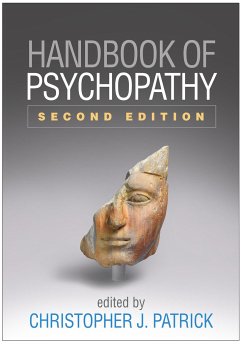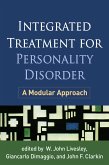Handbook of Psychopathy
Herausgeber: Patrick, Christopher J
Handbook of Psychopathy
Herausgeber: Patrick, Christopher J
- Gebundenes Buch
- Merkliste
- Auf die Merkliste
- Bewerten Bewerten
- Teilen
- Produkt teilen
- Produkterinnerung
- Produkterinnerung
Widely considered the go-to reference--and now extensively revised with over 65% new material--this authoritative handbook surveys the landscape of current knowledge on psychopathy and addresses essential clinical and applied topics. Leading researchers explore major theoretical models; symptomatology and diagnostic subtypes; assessment methods; developmental pathways; and causal influences, from genes and neurobiology to environmental factors. The volume examines manifestations of psychopathy in specific populations as well as connections to antisocial behavior and recidivism.
Andere Kunden interessierten sich auch für
![Psychopathy Psychopathy]() Morten Birket-Smith / Theodore Millon / Erik SimonsenPsychopathy80,99 €
Morten Birket-Smith / Theodore Millon / Erik SimonsenPsychopathy80,99 €![The Routledge International Handbook of Human Aggression The Routledge International Handbook of Human Aggression]() The Routledge International Handbook of Human Aggression45,99 €
The Routledge International Handbook of Human Aggression45,99 €![Treating Pathological Narcissism with Transference-Focused Psychotherapy Treating Pathological Narcissism with Transference-Focused Psychotherapy]() Diana Diamond (CUNY (Emerita)Treating Pathological Narcissism with Transference-Focused Psychotherapy112,99 €
Diana Diamond (CUNY (Emerita)Treating Pathological Narcissism with Transference-Focused Psychotherapy112,99 €![Mentalizing in Psychotherapy Mentalizing in Psychotherapy]() Carla Sharp (United States University of Houston)Mentalizing in Psychotherapy45,99 €
Carla Sharp (United States University of Houston)Mentalizing in Psychotherapy45,99 €![Treating Pathological Narcissism with Transference-Focused Psychotherapy Treating Pathological Narcissism with Transference-Focused Psychotherapy]() Diana Diamond (CUNY (Emerita)Treating Pathological Narcissism with Transference-Focused Psychotherapy58,99 €
Diana Diamond (CUNY (Emerita)Treating Pathological Narcissism with Transference-Focused Psychotherapy58,99 €![Integrated Treatment for Personality Disorder Integrated Treatment for Personality Disorder]() Integrated Treatment for Personality Disorder86,99 €
Integrated Treatment for Personality Disorder86,99 €![Desistance from Sex Offending Desistance from Sex Offending]() D. Richard LawsDesistance from Sex Offending60,99 €
D. Richard LawsDesistance from Sex Offending60,99 €-
-
-
Widely considered the go-to reference--and now extensively revised with over 65% new material--this authoritative handbook surveys the landscape of current knowledge on psychopathy and addresses essential clinical and applied topics. Leading researchers explore major theoretical models; symptomatology and diagnostic subtypes; assessment methods; developmental pathways; and causal influences, from genes and neurobiology to environmental factors. The volume examines manifestations of psychopathy in specific populations as well as connections to antisocial behavior and recidivism.
Hinweis: Dieser Artikel kann nur an eine deutsche Lieferadresse ausgeliefert werden.
Hinweis: Dieser Artikel kann nur an eine deutsche Lieferadresse ausgeliefert werden.
Produktdetails
- Produktdetails
- Verlag: Guilford Publications
- 2 ed
- Seitenzahl: 828
- Erscheinungstermin: 17. Mai 2018
- Englisch
- Abmessung: 261mm x 187mm x 48mm
- Gewicht: 1652g
- ISBN-13: 9781462535132
- ISBN-10: 1462535135
- Artikelnr.: 48967053
- Herstellerkennzeichnung
- Libri GmbH
- Europaallee 1
- 36244 Bad Hersfeld
- gpsr@libri.de
- Verlag: Guilford Publications
- 2 ed
- Seitenzahl: 828
- Erscheinungstermin: 17. Mai 2018
- Englisch
- Abmessung: 261mm x 187mm x 48mm
- Gewicht: 1652g
- ISBN-13: 9781462535132
- ISBN-10: 1462535135
- Artikelnr.: 48967053
- Herstellerkennzeichnung
- Libri GmbH
- Europaallee 1
- 36244 Bad Hersfeld
- gpsr@libri.de
Christopher J. Patrick, PhD, is Professor of Psychology at Florida State University. His research interests include psychopathy, antisocial behavior, substance abuse, personality, fear and fearlessness, psychophysiology, and affective and cognitive neuroscience, and he is author of more than 270 articles and chapters on these topics. Dr. Patrick is past president of the Society for the Scientific Study of Psychopathy (SSSP) and the Society for Psychophysiological Research (SPR), a recipient of Early Career awards from SPR and the American Psychological Association (APA), and a recipient of SSSP's Lifetime Career Contribution award. He is also a Fellow of APA and of the Association for Psychological Science. Dr. Patrick served as a workgroup member for the Research Diagnostic Criteria initiative of the National Institute of Mental Health and as a scientific advisor to the DSM-5 Personality Disorders Workgroup. He is currently a member of the American Psychiatric Association's Review Committee for Externalizing Disorders and Personality Disorders, which evaluates proposed changes to DSM-5.
I. Theoretical and Empirical Foundations of Psychopathy 1. Psychopathy as Masked Pathology
Christopher J. Patrick 2. Psychopathy
Sociopathy
and Antisocial Personality Disorder
David T. Lykken Commentary: A Minnesota Perspective on Lykken's "Psychopathy
Sociopathy
and Antisocial Personality Disorder
" William G. Iacono 3. The PCL-R Assessment of Psychopathy
Robert D. Hare
Craig S. Neumann
& Andreas Mokros 4. The Response Modulation Hypothesis: Formulation
Development
and Implications for Psychopathy
Rachel Bencic Hamilton & Joseph P. Newman 5. Temperament Risk Factors for Psychopathy
Don C. Fowles II. Distinct Phenotypic Facets of Psychopathy 6. Externalizing Proneness and Psychopathy
Lindsay D. Nelson & Jens Foell 7. Callous-Unemotional Traits
Essi Viding & Eva R. Kimonis 8. Boldness: Conceptual and Methodological Issues
Scott O. Lilienfeld
Ashley L. Watts
Sarah Francis Smith
& Robert D. Latzman III. Assessment and Diagnosis of Psychopathy 9. Capturing Psychopathic Personality: Penetrating the Mask of Sanity through Clinical Interview
David J. Cooke & Caroline Logan 10. The Self-Report Assessment of Psychopathy: Challenges
Pitfalls
and Promises
Martin Sellbom
Scott O. Lilienfeld
Katherine A. Fowler
& Kristen L. McCrary 11. Psychopathy and Personality: An Articulation of the Benefits of a Trait-Based Approach
Donald R. Lynam
Joshua D. Miller
& Karen J. Derefinko 12. Psychopathy and DSM-5 Psychopathology
Thomas A. Widiger & Cristina Crego 13. Variants ("Subtypes") of Psychopathy
Brian M. Hicks & Laura E. Drislane IV. Etiology and Mechanisms of Psychopathy 14. Genetic and Environmental Influences on Psychopathy and Antisocial Behavior
Irwin D. Waldman
Soo Hyun Rhee
Devon LoParo
& Yunsoo Park 15. Family Background and Psychopathy
David P. Farrington & Henriette Bergstrøm 16. The Neuroanatomical Bases of Psychopathy: A Review of Brain Imaging Findings
Yaling Yang & Adrian Raine 17. Psychopathy and Brain Function: Insights from Neuroimaging Research
R. James R. Blair
Harma Meffert
Soonjo Hwang
& Stuart F. White 18. Cognitive and Emotional Processing in Psychopathy
Christopher J. Patrick 19. Psychopathy and Developmental Pathways to Antisocial Behavior in Youth
Paul J. Frick & Monica A. Marsee V. Psychopathy in Specific Subpopulations 20. Psychopathy in Children and Adolescents: Assessment and Critical Questions Regarding Conceptualization
Randall T. Salekin
Henrik Andershed
& Abby P. Clark 21. Psychopathy in Women: Assessment
Manifestations
and Etiology
Edelyn Verona & Jennifer Vitale 22. Cultural and Ethnic Variations in Psychopathy
Kostas Fanti
Alexandros Lordos
Elizabeth A. Sullivan
& David S. Kosson 23. Deviance at Its Darkest: Serial Murder and Psychopathy
Eric W. Hickey
Bethany K. Walters
Laura E. Drislane
Isabella M. Palumbo
& Christopher J. Patrick 24. Successful Psychopathy
Stephen D. Benning
Noah C. Venables
& Jason R. Hall VI. Clinical and Applied Issues in Psychopathy 25. Psychopathy and Aggression
Stephen Porter
Michael T. Woodworth
& Pamela J. Black 26. Psychopathy and Substance Use Disorders
Jarrod M. Ellingson
Andrew K. Littlefield
Alvaro Vergés
& Kenneth J. Sher 27. The Role of Psychopathy in Sexual Coercion against Women: An Update and Expansion
Raymond A. Knight & Jean-Pierre Guay 28. Risk for Criminal Recidivism: The Role of Psychopathy
Kevin S. Douglas
Gina M. Vincent
& John F. Edens 29. Treatment of Adults and Juveniles with Psychopathy
Devon Polaschek & Jennifer L. Skeem 30. Legal and Ethical Issues in the Assessment and Treatment of Psychopathy
John F. Edens
John Petrila
& Shannon E. Kelley VII. Conclusions and Future Directions 31. Understanding Psychopathy: Where We Are
Where We Can Go
Dustin B. Wygant
Dustin A. Pardini
Abigail A. Marsh
& Christopher J. Patrick
Christopher J. Patrick 2. Psychopathy
Sociopathy
and Antisocial Personality Disorder
David T. Lykken Commentary: A Minnesota Perspective on Lykken's "Psychopathy
Sociopathy
and Antisocial Personality Disorder
" William G. Iacono 3. The PCL-R Assessment of Psychopathy
Robert D. Hare
Craig S. Neumann
& Andreas Mokros 4. The Response Modulation Hypothesis: Formulation
Development
and Implications for Psychopathy
Rachel Bencic Hamilton & Joseph P. Newman 5. Temperament Risk Factors for Psychopathy
Don C. Fowles II. Distinct Phenotypic Facets of Psychopathy 6. Externalizing Proneness and Psychopathy
Lindsay D. Nelson & Jens Foell 7. Callous-Unemotional Traits
Essi Viding & Eva R. Kimonis 8. Boldness: Conceptual and Methodological Issues
Scott O. Lilienfeld
Ashley L. Watts
Sarah Francis Smith
& Robert D. Latzman III. Assessment and Diagnosis of Psychopathy 9. Capturing Psychopathic Personality: Penetrating the Mask of Sanity through Clinical Interview
David J. Cooke & Caroline Logan 10. The Self-Report Assessment of Psychopathy: Challenges
Pitfalls
and Promises
Martin Sellbom
Scott O. Lilienfeld
Katherine A. Fowler
& Kristen L. McCrary 11. Psychopathy and Personality: An Articulation of the Benefits of a Trait-Based Approach
Donald R. Lynam
Joshua D. Miller
& Karen J. Derefinko 12. Psychopathy and DSM-5 Psychopathology
Thomas A. Widiger & Cristina Crego 13. Variants ("Subtypes") of Psychopathy
Brian M. Hicks & Laura E. Drislane IV. Etiology and Mechanisms of Psychopathy 14. Genetic and Environmental Influences on Psychopathy and Antisocial Behavior
Irwin D. Waldman
Soo Hyun Rhee
Devon LoParo
& Yunsoo Park 15. Family Background and Psychopathy
David P. Farrington & Henriette Bergstrøm 16. The Neuroanatomical Bases of Psychopathy: A Review of Brain Imaging Findings
Yaling Yang & Adrian Raine 17. Psychopathy and Brain Function: Insights from Neuroimaging Research
R. James R. Blair
Harma Meffert
Soonjo Hwang
& Stuart F. White 18. Cognitive and Emotional Processing in Psychopathy
Christopher J. Patrick 19. Psychopathy and Developmental Pathways to Antisocial Behavior in Youth
Paul J. Frick & Monica A. Marsee V. Psychopathy in Specific Subpopulations 20. Psychopathy in Children and Adolescents: Assessment and Critical Questions Regarding Conceptualization
Randall T. Salekin
Henrik Andershed
& Abby P. Clark 21. Psychopathy in Women: Assessment
Manifestations
and Etiology
Edelyn Verona & Jennifer Vitale 22. Cultural and Ethnic Variations in Psychopathy
Kostas Fanti
Alexandros Lordos
Elizabeth A. Sullivan
& David S. Kosson 23. Deviance at Its Darkest: Serial Murder and Psychopathy
Eric W. Hickey
Bethany K. Walters
Laura E. Drislane
Isabella M. Palumbo
& Christopher J. Patrick 24. Successful Psychopathy
Stephen D. Benning
Noah C. Venables
& Jason R. Hall VI. Clinical and Applied Issues in Psychopathy 25. Psychopathy and Aggression
Stephen Porter
Michael T. Woodworth
& Pamela J. Black 26. Psychopathy and Substance Use Disorders
Jarrod M. Ellingson
Andrew K. Littlefield
Alvaro Vergés
& Kenneth J. Sher 27. The Role of Psychopathy in Sexual Coercion against Women: An Update and Expansion
Raymond A. Knight & Jean-Pierre Guay 28. Risk for Criminal Recidivism: The Role of Psychopathy
Kevin S. Douglas
Gina M. Vincent
& John F. Edens 29. Treatment of Adults and Juveniles with Psychopathy
Devon Polaschek & Jennifer L. Skeem 30. Legal and Ethical Issues in the Assessment and Treatment of Psychopathy
John F. Edens
John Petrila
& Shannon E. Kelley VII. Conclusions and Future Directions 31. Understanding Psychopathy: Where We Are
Where We Can Go
Dustin B. Wygant
Dustin A. Pardini
Abigail A. Marsh
& Christopher J. Patrick
I. Theoretical and Empirical Foundations of Psychopathy 1. Psychopathy as Masked Pathology
Christopher J. Patrick 2. Psychopathy
Sociopathy
and Antisocial Personality Disorder
David T. Lykken Commentary: A Minnesota Perspective on Lykken's "Psychopathy
Sociopathy
and Antisocial Personality Disorder
" William G. Iacono 3. The PCL-R Assessment of Psychopathy
Robert D. Hare
Craig S. Neumann
& Andreas Mokros 4. The Response Modulation Hypothesis: Formulation
Development
and Implications for Psychopathy
Rachel Bencic Hamilton & Joseph P. Newman 5. Temperament Risk Factors for Psychopathy
Don C. Fowles II. Distinct Phenotypic Facets of Psychopathy 6. Externalizing Proneness and Psychopathy
Lindsay D. Nelson & Jens Foell 7. Callous-Unemotional Traits
Essi Viding & Eva R. Kimonis 8. Boldness: Conceptual and Methodological Issues
Scott O. Lilienfeld
Ashley L. Watts
Sarah Francis Smith
& Robert D. Latzman III. Assessment and Diagnosis of Psychopathy 9. Capturing Psychopathic Personality: Penetrating the Mask of Sanity through Clinical Interview
David J. Cooke & Caroline Logan 10. The Self-Report Assessment of Psychopathy: Challenges
Pitfalls
and Promises
Martin Sellbom
Scott O. Lilienfeld
Katherine A. Fowler
& Kristen L. McCrary 11. Psychopathy and Personality: An Articulation of the Benefits of a Trait-Based Approach
Donald R. Lynam
Joshua D. Miller
& Karen J. Derefinko 12. Psychopathy and DSM-5 Psychopathology
Thomas A. Widiger & Cristina Crego 13. Variants ("Subtypes") of Psychopathy
Brian M. Hicks & Laura E. Drislane IV. Etiology and Mechanisms of Psychopathy 14. Genetic and Environmental Influences on Psychopathy and Antisocial Behavior
Irwin D. Waldman
Soo Hyun Rhee
Devon LoParo
& Yunsoo Park 15. Family Background and Psychopathy
David P. Farrington & Henriette Bergstrøm 16. The Neuroanatomical Bases of Psychopathy: A Review of Brain Imaging Findings
Yaling Yang & Adrian Raine 17. Psychopathy and Brain Function: Insights from Neuroimaging Research
R. James R. Blair
Harma Meffert
Soonjo Hwang
& Stuart F. White 18. Cognitive and Emotional Processing in Psychopathy
Christopher J. Patrick 19. Psychopathy and Developmental Pathways to Antisocial Behavior in Youth
Paul J. Frick & Monica A. Marsee V. Psychopathy in Specific Subpopulations 20. Psychopathy in Children and Adolescents: Assessment and Critical Questions Regarding Conceptualization
Randall T. Salekin
Henrik Andershed
& Abby P. Clark 21. Psychopathy in Women: Assessment
Manifestations
and Etiology
Edelyn Verona & Jennifer Vitale 22. Cultural and Ethnic Variations in Psychopathy
Kostas Fanti
Alexandros Lordos
Elizabeth A. Sullivan
& David S. Kosson 23. Deviance at Its Darkest: Serial Murder and Psychopathy
Eric W. Hickey
Bethany K. Walters
Laura E. Drislane
Isabella M. Palumbo
& Christopher J. Patrick 24. Successful Psychopathy
Stephen D. Benning
Noah C. Venables
& Jason R. Hall VI. Clinical and Applied Issues in Psychopathy 25. Psychopathy and Aggression
Stephen Porter
Michael T. Woodworth
& Pamela J. Black 26. Psychopathy and Substance Use Disorders
Jarrod M. Ellingson
Andrew K. Littlefield
Alvaro Vergés
& Kenneth J. Sher 27. The Role of Psychopathy in Sexual Coercion against Women: An Update and Expansion
Raymond A. Knight & Jean-Pierre Guay 28. Risk for Criminal Recidivism: The Role of Psychopathy
Kevin S. Douglas
Gina M. Vincent
& John F. Edens 29. Treatment of Adults and Juveniles with Psychopathy
Devon Polaschek & Jennifer L. Skeem 30. Legal and Ethical Issues in the Assessment and Treatment of Psychopathy
John F. Edens
John Petrila
& Shannon E. Kelley VII. Conclusions and Future Directions 31. Understanding Psychopathy: Where We Are
Where We Can Go
Dustin B. Wygant
Dustin A. Pardini
Abigail A. Marsh
& Christopher J. Patrick
Christopher J. Patrick 2. Psychopathy
Sociopathy
and Antisocial Personality Disorder
David T. Lykken Commentary: A Minnesota Perspective on Lykken's "Psychopathy
Sociopathy
and Antisocial Personality Disorder
" William G. Iacono 3. The PCL-R Assessment of Psychopathy
Robert D. Hare
Craig S. Neumann
& Andreas Mokros 4. The Response Modulation Hypothesis: Formulation
Development
and Implications for Psychopathy
Rachel Bencic Hamilton & Joseph P. Newman 5. Temperament Risk Factors for Psychopathy
Don C. Fowles II. Distinct Phenotypic Facets of Psychopathy 6. Externalizing Proneness and Psychopathy
Lindsay D. Nelson & Jens Foell 7. Callous-Unemotional Traits
Essi Viding & Eva R. Kimonis 8. Boldness: Conceptual and Methodological Issues
Scott O. Lilienfeld
Ashley L. Watts
Sarah Francis Smith
& Robert D. Latzman III. Assessment and Diagnosis of Psychopathy 9. Capturing Psychopathic Personality: Penetrating the Mask of Sanity through Clinical Interview
David J. Cooke & Caroline Logan 10. The Self-Report Assessment of Psychopathy: Challenges
Pitfalls
and Promises
Martin Sellbom
Scott O. Lilienfeld
Katherine A. Fowler
& Kristen L. McCrary 11. Psychopathy and Personality: An Articulation of the Benefits of a Trait-Based Approach
Donald R. Lynam
Joshua D. Miller
& Karen J. Derefinko 12. Psychopathy and DSM-5 Psychopathology
Thomas A. Widiger & Cristina Crego 13. Variants ("Subtypes") of Psychopathy
Brian M. Hicks & Laura E. Drislane IV. Etiology and Mechanisms of Psychopathy 14. Genetic and Environmental Influences on Psychopathy and Antisocial Behavior
Irwin D. Waldman
Soo Hyun Rhee
Devon LoParo
& Yunsoo Park 15. Family Background and Psychopathy
David P. Farrington & Henriette Bergstrøm 16. The Neuroanatomical Bases of Psychopathy: A Review of Brain Imaging Findings
Yaling Yang & Adrian Raine 17. Psychopathy and Brain Function: Insights from Neuroimaging Research
R. James R. Blair
Harma Meffert
Soonjo Hwang
& Stuart F. White 18. Cognitive and Emotional Processing in Psychopathy
Christopher J. Patrick 19. Psychopathy and Developmental Pathways to Antisocial Behavior in Youth
Paul J. Frick & Monica A. Marsee V. Psychopathy in Specific Subpopulations 20. Psychopathy in Children and Adolescents: Assessment and Critical Questions Regarding Conceptualization
Randall T. Salekin
Henrik Andershed
& Abby P. Clark 21. Psychopathy in Women: Assessment
Manifestations
and Etiology
Edelyn Verona & Jennifer Vitale 22. Cultural and Ethnic Variations in Psychopathy
Kostas Fanti
Alexandros Lordos
Elizabeth A. Sullivan
& David S. Kosson 23. Deviance at Its Darkest: Serial Murder and Psychopathy
Eric W. Hickey
Bethany K. Walters
Laura E. Drislane
Isabella M. Palumbo
& Christopher J. Patrick 24. Successful Psychopathy
Stephen D. Benning
Noah C. Venables
& Jason R. Hall VI. Clinical and Applied Issues in Psychopathy 25. Psychopathy and Aggression
Stephen Porter
Michael T. Woodworth
& Pamela J. Black 26. Psychopathy and Substance Use Disorders
Jarrod M. Ellingson
Andrew K. Littlefield
Alvaro Vergés
& Kenneth J. Sher 27. The Role of Psychopathy in Sexual Coercion against Women: An Update and Expansion
Raymond A. Knight & Jean-Pierre Guay 28. Risk for Criminal Recidivism: The Role of Psychopathy
Kevin S. Douglas
Gina M. Vincent
& John F. Edens 29. Treatment of Adults and Juveniles with Psychopathy
Devon Polaschek & Jennifer L. Skeem 30. Legal and Ethical Issues in the Assessment and Treatment of Psychopathy
John F. Edens
John Petrila
& Shannon E. Kelley VII. Conclusions and Future Directions 31. Understanding Psychopathy: Where We Are
Where We Can Go
Dustin B. Wygant
Dustin A. Pardini
Abigail A. Marsh
& Christopher J. Patrick








